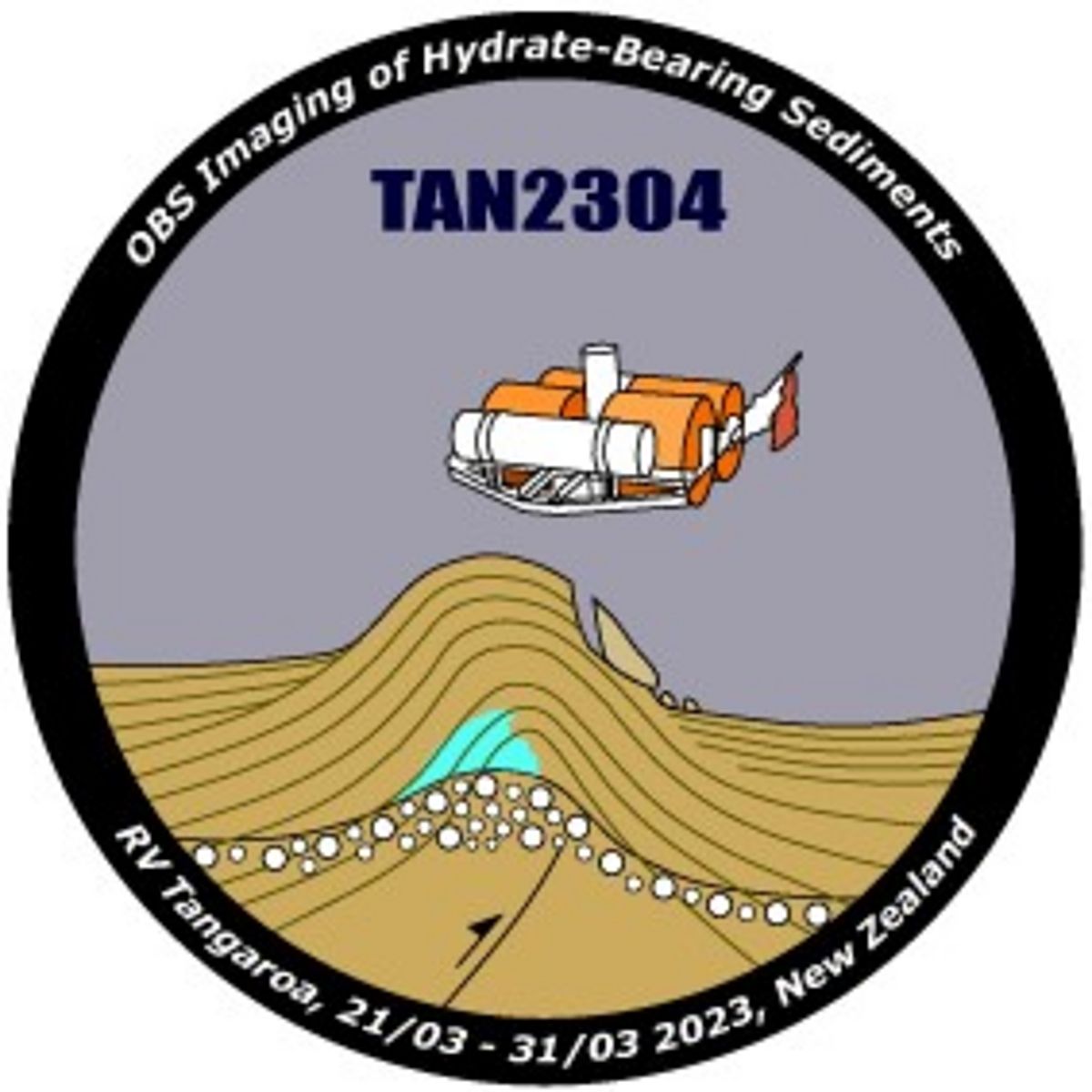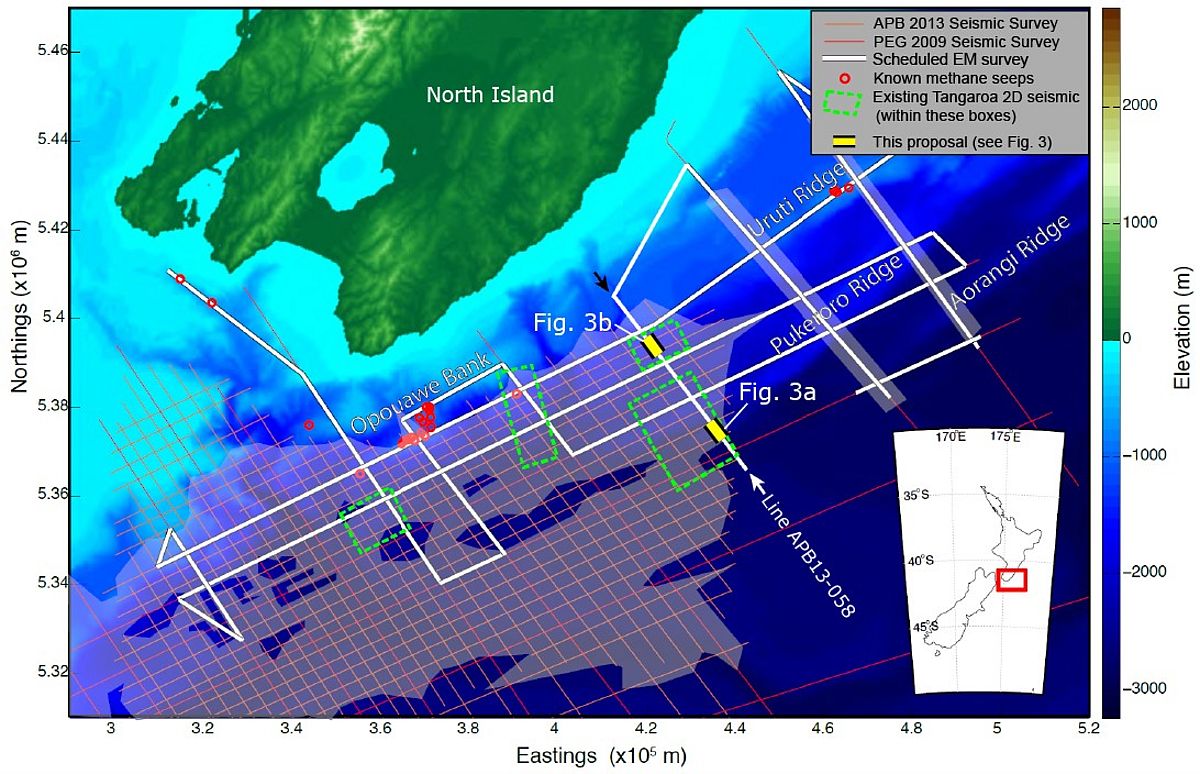Phone: +49 431 600-2329
Mail: jbialas@geomar.de
Phone: +49 431 600 2337
Mail: gcrutchley@geomar.de

Marine gas hydrates have received much attention in recent decades {Collett, 2014}. Gas hydrates consist of gas molecules stored in a rigid water-lattice, stable under high pressure and low temperature conditions {SloanJr, 2007}. There have been numerous attempts to quantify the global gas hydrate inventory {e.g. Mienert et al., 2022, Wallmann, 2012, Kvenvolden, 2013, Milkov, 2004, Pinero, 2013}, which is crucial for understanding the role of gas hydrates in Earth’s carbon cycle. The gas hydrate system ultimately regulates how methane flows from buried marine sediments, through the seafloor, and into the oceans. The interactions at the seafloor influence the distribution and diversity of biological communities that use methane as their lifeblood {e.g. Bowden, 2013}. The seepage of methane into the water column further influences the biogeochemistry of the oceans, with important implications for ocean acidification {e.g. Biastoch, 2011}.
In seismic measurements, a seafloor (bottom) simulating reflection (BSR) of reversed polarity compared with the seafloor, caused by free gas beneath hydrate, is the first order identifier of the base of gas hydrate stability (BGHS) {e.g. Minshull, 2019, Moridis, 2011}. However, gas hydrates may be present in the absence of a BSR {Andreassen, 1997}. Seismic wide-angle measurements provide information on hydrate distribution and concentration from velocity anomalies {Bialas et al., 2020, Crutchley, 2016}. Similarly, controlled source electromagnetic (CSEM) methods, sensitive to the resistivity of sediments {Hoelz, 2015}, provide additional information on sediment pore fill, which can be interpreted for gas and hydrate distribution and concentration {Bialas et al., 2020, Schwalenberg, 2017}.
A curiosity for several decades has been the existence in some gas hydrate provinces for double, or even multiple, BSRs (e.g. Bangs, 2005; Popescu, 2006, Garcia, 2007, Auguy, 2017, Zander et al., 2017). In some cases, it may be possible that such occurrences indicate the existence of different gas hydrate structures with different stability fields (e.g. Pecher et al. 2017). In many (perhaps most) cases, the deeper BSR or BSRs appear to represent a paleo-BGHS that existed at some time in the geological past, where the pressure and temperature regime was different. The changes in pressure and temperature regime that cause changes in the stratigraphic level of the BGHS can be caused by rapid and on-going sedimentation (e.g. Zander, 2017), or possibly also by post-glacial warming {Bangs, 2005} or tectonic uplift. Zander et al. {2017} demonstrated that multiple BSRs in the Danube Fan, Black Sea, correlate with former seafloors that were stable several tens of thousands of years ago, likely during glacial sealevel lowstands. The persistence of the BSRs over such long time periods is curious, and would suggest that either a) hydrate dissociation takes a very long time to propagate through the system after environmental changes, or b) remnants of free gas from the former BGHS remain in place after the gas hydrates have long since dissociated.
Despite the advances made in recent decades in terms of characterizing and quantifying gas hydrate distribution {e.g. Wallmann, 2012, Pinero, 2013, Kvenvolden, 2013, Bogoyavlensky, 2018}, there remains much uncertainty about gas hydrate concentration over large basin scales and at individual gas hydrate reservoirs. There is often a significant discrepancy between the concentration of gas hydrate predicted using seismic methods (i.e. using compressional and shear wave velocities) and concentrations predicted from controlled-source electromagnetic methods (i.e. using resistivity and Archie’s Law){Berndt, 2019}. An example of where the two methods for estimating hydrate concentrations could diverge majorly is if there is significant free gas occurring in close proximity to the gas hydrate deposits. For P-wave velocities, the occurrence of free gas will drastically reduce the velocities of the sediments, even at low concentrations {Domenico, 2012}. For CSEM measurements, on the other hand, both free gas and gas hydrate will add to the bulk resistivity of the pore space {e.g. Attias, 2016}. As such, if the occurrence of free gas together with gas hydrate cannot be isolated, there will continue to be major discrepancies between estimations of gas hydrate concentration derived from these two methods. Knowledge of additional parameters is required to provide further physical properties of the gas hydrate stability zone.
Converted shear wave (Vs) information from four component OBS measurements are sensitive to the shear modulus and can therefore help to distinguish between pore filling or cementing types of hydrate formation {Sava, 2009, Dannowski, 2017}. Based on this knowledge, corresponding lab experiments or rock physics models can be used to derive hydrate saturation estimates. In addition, converted shear waves can provide a much better resolution of sub-bottom strata than Vp images {Hardage, 2009}.
Crutchley et al. {2018} investigated the large-scale distribution of concentrated gas hydrates along the accretionary Hikurangi margin. They interpreted that a pronounced asymmetry caused by preferential sedimentation on the landward sides of ridges and erosion on the seaward sides has implications for the gas hydrate system. The sedimentation on the landward side results in seafloor uplift and uplift of the BGHS, which results in “gas hydrate recycling” – the liberation of free gas from gas hydrates that can then migrate back into the hydrate stability zone to re-form as gas hydrates. Paull et al. {1993} suggested that such recycling of hydrate leads to the generation of higher saturation gas hydrate deposits. In contrast, erosion on the seaward sides of ridges suppresses the BGHS and is not likely to lead to hydrate recycling and concentrated gas hydrate deposits. As a result, hydrate distribution across an accretionary margin might often be unbalanced as a result of these relationships between sedimentation and erosion {Crutchley, 2018}.
Seismic imaging of the differences in hydrate formation depends on the amount of hydrate formed but also on the seismic frequency available with the data acquisition {e.g. Petersen, 2010, Riedel, 2009}. The low frequency content of available data makes it difficult to understand the onset and extent of hydrate formation and gas injection as the seismic events are altered by “tuning” effects caused by thin sediment layers. Tuning effects influence both the reflection strength and the phase of reflections, which makes it difficult to test the proposed model by Crutchley et al. {2018} regarding an uneven distribution and concentration of hydrates. Again, converted shear waves of four component OBS can help to investigate whether higher hydrate concentration in landward dipping sediment layers are coincident with cementation, which may not be the case on the seaward sides of ridges.

Map of the existing 2D multichannel seismic network along the Hikurangi Margin. The two yellow bars on line APB13-058 indicate the position of the hydrate and gas migration structures selected for the OBS survey of this proposal.
Confirmation of the above described scenario will have important implications for our understanding of global gas hydrate budgets. Moreover, it will have consequences for more localised investigations into gas hydrate production. Future gas production from hydrates will likely depend on depressurization {e.g. Moridis, 2011} and needs to ensure that methane cannot escape towards the seafloor {Wallmann, 2009}. Data examples from the hydrate reservoirs investigated by Crutchley et al. {2018} do show seismic reflections caused by free gas within the hydrate stability zone, well above the hydrate body. As the above described model is assumed to be applicable to accretionary margins worldwide {Crutchley, 2018} it is essential to understand how gas injection into the hydrate stability zone works.
External website: https://express.adobe.com/page/efaKN3VcrFjKQ/

